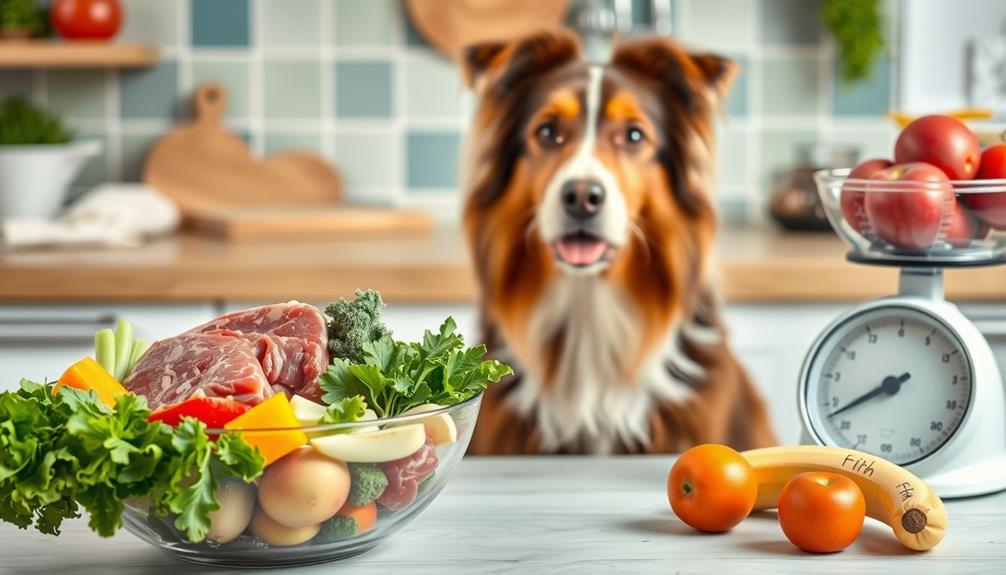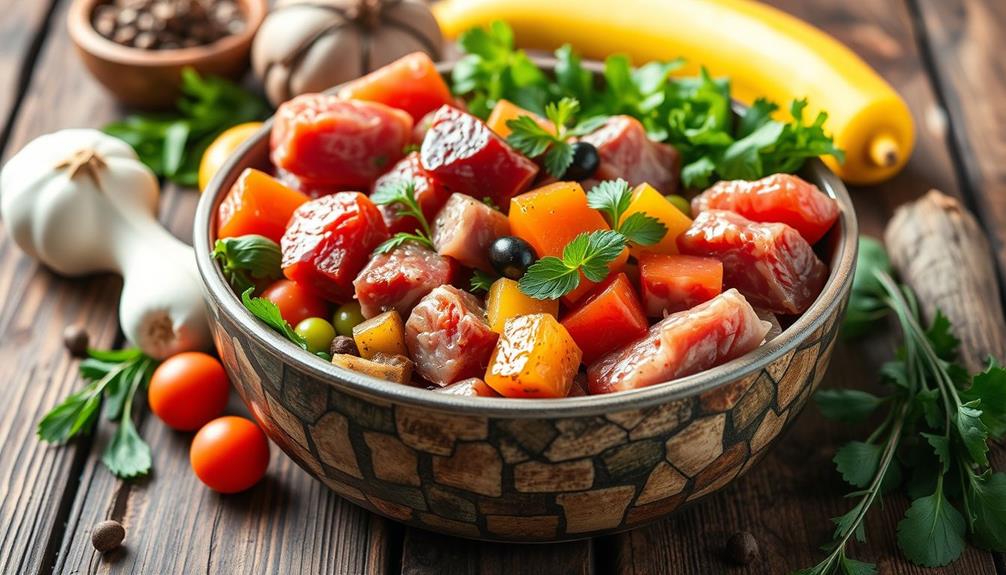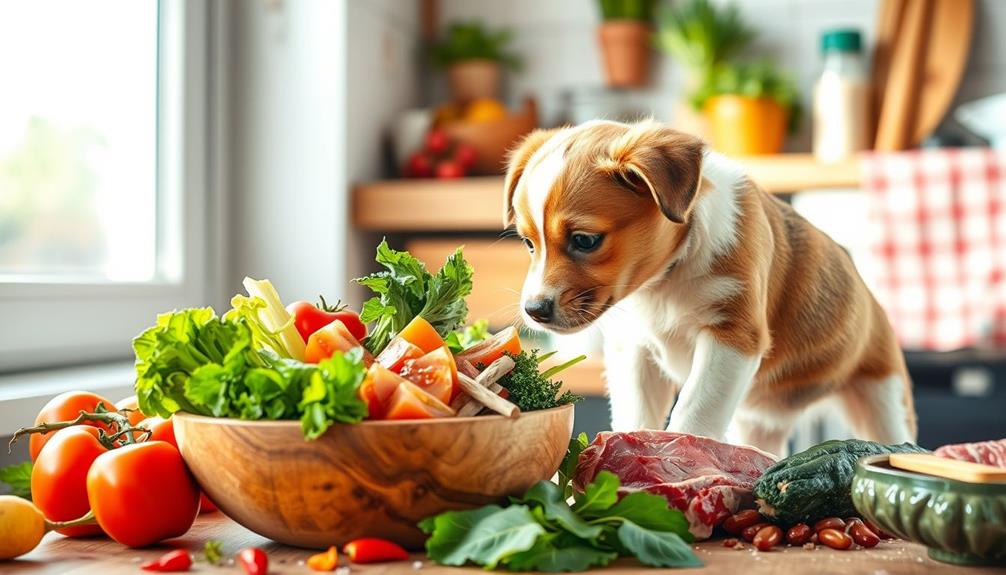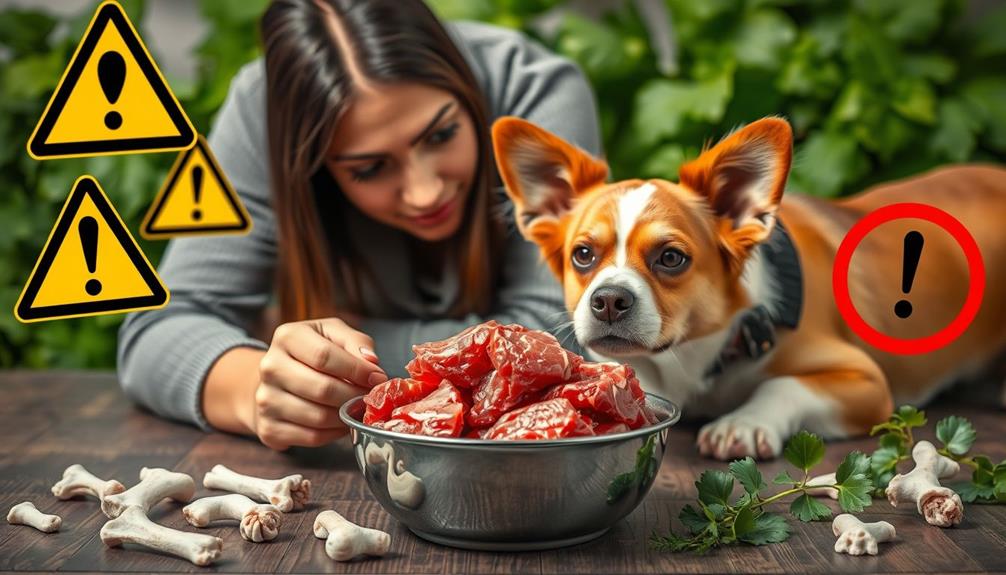To feed your dog a raw food diet, give them 2-3% of their body weight daily. If your dog is more active, increase it to 3-5%. Smaller breeds under 5 pounds may need 5-6%, while puppies typically require 5-10% due to growth. Always adjust based on their activity level and monitor their weight to guarantee they stay healthy. A gradual shift to a raw diet is key, and checking for digestive health is important. Want to discover more tips about raw diets and your dog's nutrition? There's plenty left to explore!
Key Takeaways
- Adult dogs need 2-3% of their body weight in raw food daily; active dogs may require 3-5%.
- Smaller dogs (up to 5 pounds) should receive 5-6% of their body weight.
- Puppies typically need 5-10% of their body weight, with 3-4 meals per day for young puppies.
- Adjust food portions based on activity level, health, and body condition monitoring.
- Gradually transition to a raw diet over a week to avoid digestive issues.
Understanding Raw Food Portions
When figuring out how much raw food to feed your dog, it's vital to take into account their weight, activity level, and age. Adult dogs generally require about 2-3% of their body weight per day in raw dog food. For example, if your dog weighs 50 pounds, you'll need to provide approximately 1 to 1.5 pounds of raw food daily, preferably split into two meals.
Active dogs lean toward the higher end, needing closer to 3%, while less active dogs may need around 2%. Additionally, incorporating healthy dog snacks can enhance your dog's diet and overall wellness.
Smaller dogs often require a higher percentage of their body weight; those weighing up to 5 pounds might need 5-6% of their body weight in raw food. Puppies generally demand even more, typically around 5-10% of their current body weight daily, due to their rapid growth and energy needs.
It's important to tailor the amount of raw food you're feeding your dog based on their individual activity level, age, and overall health. This approach guarantees they receive a balanced diet that meets their specific nutritional needs.
Adjust portions as necessary to maintain their ideal weight and health.
Factors Influencing Feeding Amounts
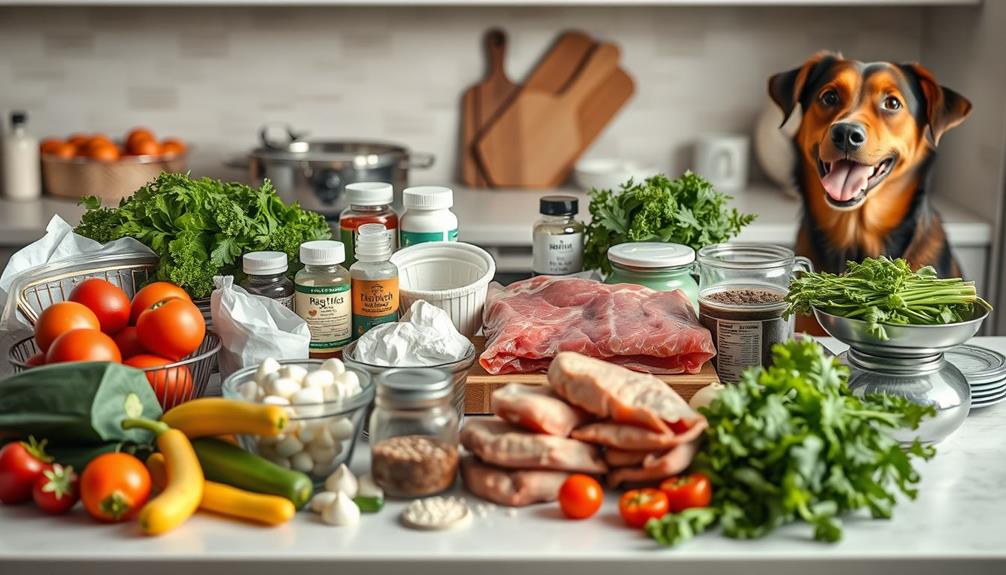
Several factors influence how much raw food your dog needs, making it imperative to assess each one carefully. First, consider your dog's body weight. Generally, a dog's daily raw food intake ranges from 2% to 5% of their body weight. Active dogs often require closer to 4-5%, while less active or overweight dogs may only need 2-3%. Additionally, it's important to factor in any health considerations, such as pre-existing conditions that may affect dietary needs, similar to how cold medications have specific recommendations based on symptoms.
Next, your dog's activity level plays a significant role. If your dog is highly active, they'll need more food to sustain their energy levels. On the other hand, if your dog is less active, you'll want to adjust their feeding amounts accordingly.
For puppies, they require a minimum of 5% of their body weight daily to support their rapid growth. It's essential to divide their meals into multiple portions throughout the day.
Using a raw food calculator can help you determine the right amount based on these factors. Regularly monitoring your dog's body condition is significant, as individual dietary needs can change over time due to age, health, and lifestyle changes.
Feeding Guidelines for Puppies
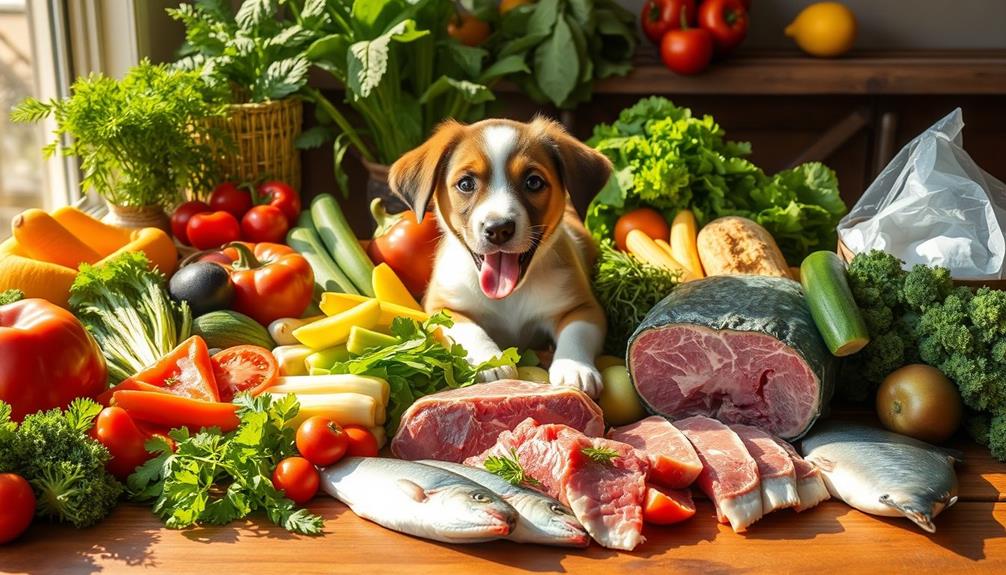
Feeding a puppy requires careful attention to their unique needs, as they grow rapidly during their early months. To provide ideal nutrition, you should offer your puppy raw food that constitutes about 5-10% of their body weight daily. This is akin to the careful dietary needs mentioned in Ultimate Hamster Care Guide.
As they reach six months of age, this amount will typically decrease to around 5%.
For very young puppies, it's best to divide their daily portion into 3-4 meals per day. As they mature, you can shift to feeding them twice daily.
Keep a close eye on your puppy's growth to guarantee they're developing healthily; you may need to adjust food quantities based on their needs.
A raw food calculator can be a handy tool to determine the appropriate daily portion based on your puppy's weight and age. Balanced nutrition is vital during this stage to support their rapid growth and energy requirements.
Transitioning to Raw Diet
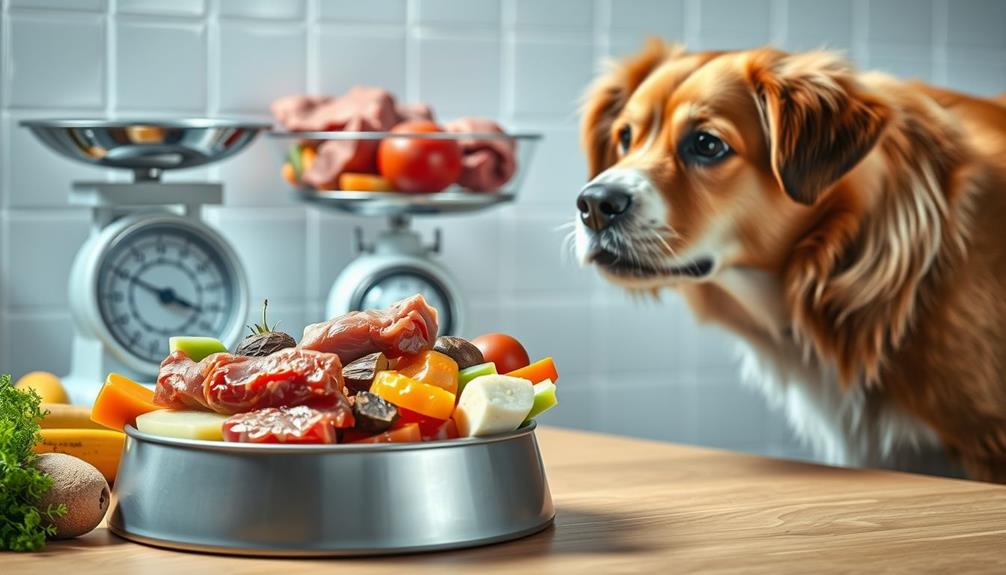
Adjusting your dog to a raw diet usually takes about a week, but if your pet has a sensitive stomach, you'll want to go slower.
Gradually increasing the raw food proportion helps prevent digestive issues, so keep an eye on how your dog responds.
It's also important to monitor their weight during this process to guarantee they're adjusting well.
Additionally, consulting with a veterinarian about financial considerations for elderly care can provide insights on how to manage any health-related expenses that may arise during this adjustment.
Transition Duration Considerations
When moving your dog to a raw diet, the duration of the change can vary greatly based on their individual health and adaptability.
For healthy dogs, you might see a smooth adjustment in as little as a week, while those with digestive issues may need a more gradual change lasting several weeks.
Here are some key considerations for change duration:
- Healthy Dogs: Often adapt within a week.
- Digestive Issues: Require a much slower introduction to avoid gastrointestinal upset.
- Gradual Change: Slowly increase raw food while decreasing their previous diet.
- Monitor Your Dog: Observe for any signs of discomfort or digestive problems.
- Consult a Veterinarian: Always seek professional advice if you notice any issues.
Monitoring Digestive Health
Monitoring your dog's digestive health is essential during the change to a raw diet. As you introduce raw food, closely observe stool consistency and frequency; smaller, firmer stools usually indicate better digestion. A gradual change over a week is ideal for healthy dogs, while those with digestive issues may need an even slower process.
| Aspect | What to Monitor | Action if Concerned |
|---|---|---|
| Stool Consistency | Firmness and size | Adjust diet and consult vet |
| Appetite | Changes in eating habits | Monitor closely; guarantee intake |
| Weight Loss | Loss exceeding 1-2% weekly | Contact your veterinarian |
During this change phase, keep track of any changes in appetite, energy levels, and overall behavior to assess how well your dog adapts. If you notice significant weight loss or other concerning symptoms, don't hesitate to reach out to your veterinarian. Incorporating a base mix of dehydrated veggies and fruits can help ease the change while supporting digestive health with necessary fiber and nutrients.
Benefits of a Raw Diet
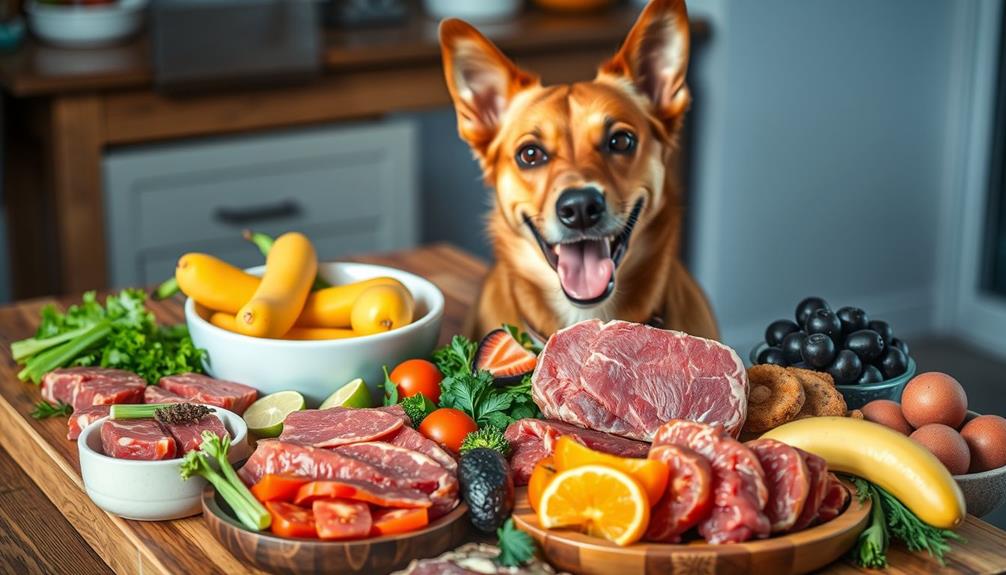
Switching to a raw diet can greatly boost your dog's digestion efficiency, making it easier for them to absorb nutrients.
Additionally, incorporating fresh ingredients may provide antioxidants that support overall health, similar to the benefits seen in Cranberry Juice Consumption.
You'll also notice healthier skin and a shinier coat, giving your pet a vibrant look.
Plus, a raw diet can enhance their immune function, leading to a happier, healthier dog overall.
Improved Digestion Efficiency
A raw diet can greatly enhance your dog's digestion efficiency, leading to better nutrient absorption and healthier bowel movements. When you switch to a raw food diet, you'll likely notice significant improvements in your dog's overall digestive health.
This is primarily due to the high bioavailability of nutrients found in fresh, whole ingredients, which makes it easier for dogs to digest and process their food intake. Additionally, incorporating a balanced diet rich in fruits and vegetables can further support your dog's digestive system and overall well-being.
Here are some key benefits of improved digestion efficiency through raw feeding:
- Better nutrient absorption: Your dog can utilize nutrients more effectively.
- Reduced gastrointestinal issues: Natural ingredients are easier for dogs to digest.
- Smaller, firmer stools: Improved digestion leads to less waste.
- Healthier gut microbiome: A balanced diet supports beneficial gut bacteria.
- Comfortable digestion: Dogs experience less bloating and discomfort.
Even incorporating just 25% raw food into your dog's diet can lead to noticeable improvements.
Healthier Skin and Coat
Your dog's skin and coat can flourish with the right raw diet, as it provides essential nutrients that promote health and liveliness. Raw food is rich in omega fatty acids, which play an important role in hydrating the skin and reducing inflammation. This means a healthier skin and a shinier coat for your furry friend.
Additionally, incorporating essential oils for skin health can further enhance the benefits of a raw diet, providing additional support for skin hydration and overall wellness.
When you switch to a raw diet, you often notice improved digestion. This enhances nutrient absorption, allowing the vitamins and minerals necessary for skin health to be utilized more effectively.
Plus, by eliminating fillers and artificial additives commonly found in commercial kibble, you can reduce the incidence of skin allergies and irritations.
Incorporating organ meats into your dog's raw food regimen also boosts skin health. Organ meats are packed with essential nutrients like zinc and B vitamins, important for maintaining a vibrant coat.
Dogs on a raw diet typically experience less shedding and reduced odor, indicating improved overall skin health and decreased allergens.
Enhanced Immune Function
With the right raw diet, dogs can experience a remarkable boost in immune function. This dietary change provides essential nutrients, enzymes, and amino acids that support their overall health and wellness.
When you incorporate raw food into your dog's meals, you're not just feeding them; you're enhancing their immune system. A well-balanced diet can also contribute to financial health by reducing vet bills associated with illness.
Here are some key benefits of a raw diet for immune function:
- Rich in antioxidants from fresh fruits and vegetables that combat oxidative stress.
- High-quality protein sources promote ideal muscle development and repair.
- Supports a healthy gut, critical for a robust immune response.
- May reduce allergy symptoms, leading to improved comfort and well-being.
- Offers a balanced diet, ensuring your dog receives all necessary nutrients.
Choosing Quality Raw Food
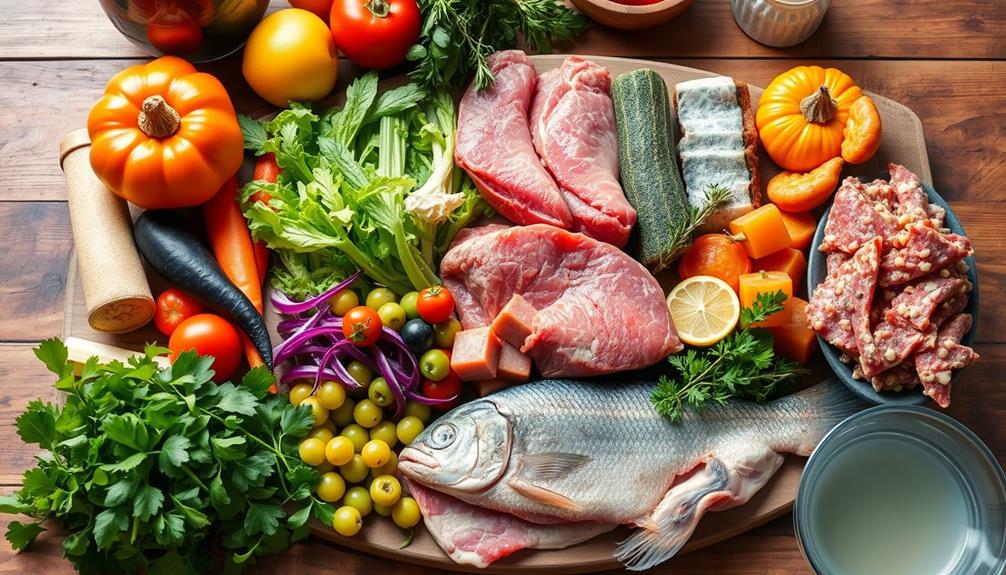
Choosing quality raw food for your dog is vital for their overall health and well-being. When selecting raw food, prioritize brands that offer complete and balanced meals. This means including a mix of muscle meat, organ meat, and finely ground bone, while avoiding fillers or artificial additives.
High-quality ingredients sourced from reputable suppliers directly impact the nutritional value of the raw food you choose. Additionally, consider how the food aligns with your dog's specific needs, much like how essential oils for skin conditions can be tailored to address particular issues.
Make certain the raw food meets AAFCO standards for nutritional adequacy, which indicates it's formulated to support your dog's health.
It's also important to check for quality control measures and safety protocols implemented by the manufacturer. These protocols guarantee consistent product safety and nutrient retention, giving you peace of mind.
Frequently Asked Questions
How Much Raw Food Should I Feed My Dog Chart?
You can use a chart to determine raw food portions based on your dog's weight and activity level. Generally, aim for 2-3% of their body weight daily, adjusting according to their specific needs and lifestyle.
How Many Times a Day Do You Feed Raw Dog Food?
You should feed your dog raw food twice a day. This schedule supports digestion and prevents issues like bloat. Adjust feeding frequency based on your dog's size, age, activity level, and overall health.
What Are the Proportions for Raw Dog Food?
To determine proportions for raw dog food, calculate your dog's weight and multiply it by 2-3% for adults, or 5-10% for puppies, adjusting based on their activity level for ideal nutrition.
How Do You Measure Raw Meat for Dogs?
To measure raw meat for your dog, weigh the food using a kitchen scale. Calculate the amount based on your dog's weight, aiming for 2-3% of their body weight, adjusting as needed for activity levels.
Conclusion
In summary, feeding your dog a raw diet requires careful consideration of their individual needs. For instance, if you have a 50-pound active Labrador, you might start with about 2.5 to 3 pounds of raw food daily, adjusting based on their energy levels and health. Remember, shifting slowly and monitoring their response is key. By choosing quality ingredients and tailoring portions, you'll guarantee your pup thrives on a raw diet that suits them perfectly.

